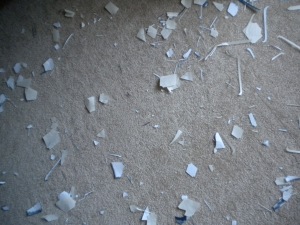I have been cutting the first set of three paper cutouts from the new “Chain Link Fence” series. Finally, tonight I feel it’s close to the home stretch.
The butterflies take a long time to make. But they are worth it.

“Falling Water” is a new paper cutout I just completed. It is the first piece I do not use frame and it hangs like a curtain off the wall to cast a shadow.
It is a relatively large piece in 27.5×50 inches. The piece combines two of my signature motifs – moving water and the chain link fence.
I am very happy with how it turns out.
“Falling Water” will debut in “Paper,” a group exhibition in Pittsburgh’s historic North Side at Artist Image Resource. The exhibition opens on April 2 and continues thru May 23.
written by Mary Thomas, art critic, Pittsburgh Post-Gazette, March 23, 2010
It is a well-written, concise summary of my current work and career thus far.
“In the Frame” – Artist Bovey Lee, video by Pittsburgh Post-Gazette, March 24, 2010
The video focuses on my early art training and influences in Hong Kong, where I was born and raised, and its impact on my current work as a cut paper artist.
Video length: 5 minute 57 seconds
Who:
Where:
What:
Chinese paper cutting is an ancient folk art that has been around for thousands of years. Seen here is one of the five oldest paper cutouts discovered in a Xinjiang archeology site (where is Xinjiang?). It is dated back to the Southern and Northern dynasties (486-581).
I am amazed by the beauty of the geometric, symmetrical, and complex design in this very early paper cutout. The tool used to make it appears to be capable of fairly detail cutting, such as the teeth on the outer edge. And folding also seems clearly utilized to create the pattern.
Source: Berliner, Nancy Zheng. Chinese Folk Art, Canada: Little, Brown and Company, 1986.

The Pittsburgh Post-Gazette came to my studio on Tuesday to make a video of my work and process. It will be up on their Web site next week.
This is the first video documenting my work and making it was quite interesting. My creative process is necessarily solitary. Apparently, I was not used to have a camera in my face so it felt awkward in the beginning. There was no rehearsal or do-over. It was very spontaneous. Besides the videographer, the newspaper’s art critic was also present. All the questions they asked me I didn’t know ahead of time.
The video will only be a few minutes long but we did an hour of show and tell. So I am curious how it would come together after the editing.
But hopefully, the video will be interesting because there are quite a few new pieces no one has ever seen before, like the one shown here in detail shot. This piece is said to be the videographer’s favorite.
Please check back next week for the link to view the video.

Check and replied emails
Read the news
Check phone messages and reply calls
Write or think about something to write on this blog
Work on business related matters like banking, bill pay, book-keeping, filing, etc..
Research and think about ideas for paper cutouts
Do some drawings for the ideas
Make digital templates for paper cutouts
On some days, meet guests in the studio or attend business meetings/appointments
Make paper cutouts
Take photographs of artworks or prepare artworks for exhibitions
Research art related resources or work on grants, residencies, exhibitions, Web site, e-newsletter, etc.
I usually spend most of the evening and into the night to focus on making paper cutouts
If I am not cutting, I attend art events.
The other day photographer Josh Gates asked me, “Which paper cutout is the first one you’ve ever made?”
That is a great question.
It is “Beholder.”
“Beholder” is inspired by a Chinese opera mask paper cutting in my collection. Very elaborate, detail, and masculine, the main figure has one of the eyes turned into a child’s face.
I thought that was so interesting to make a piece about role reversal. The outcome is “Beholder” in which one of my eyes was replaced by my mother’s face.
And I wanted to surround us with flowers.
“Beholder” has a very special place in my heart and it is significant because it sets the tone for all other paper cutouts I have created since.
I use Chinese rice paper exclusively in my work. But is rice paper really made of rice?
It is a simple question with a complicated answer. In fact, to make it even more confusing, rice paper is called “Xuan” paper in Chinese and it is not made of rice.

Mulberry Tree

Qintan Tree
After some research, asked around, and compare notes, apparently there are many types of rice paper and they can also be made with mulberry tree and bamboo. But the best Xuan paper is from Anhui’s Jing County in China where they use the fibers from the Qintan tree bark or Pteroceltis tatarinowii, a common species of elm in that area.
Mulberry and qintan tree barks grow back again and again, while bamboo is a sustainable/renewable source.
The rice/Xuan paper made in China is not machine-pressed but hand-made. The hand-made process is sustainable. Because I use rice paper so much, it is great that both the material and process used are eco-friendly.
Top quality rice paper enjoys longevity and is beautifully uniformed in texture, color, and thickness (thinness really). The translucency and absorbency are also very consistent. It is soft yet substantial to the touch, never powdery or flimsy.
I am still researching this and will post more when there’s new information.